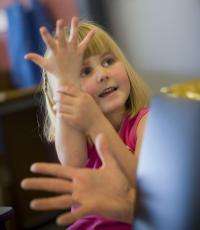It is all in the hands

We all know that feedback from ‘educators’ is very important; especially when it is related to the correct execution of an activity.
As a child, think of the physical harm you could have come to if your parents hadn’t given you feedback when you tried to cross the road without looking. Or if we weren’t given instant verbal feedback during our driving lessons when changing lanes without looking.
Feedback, delivered instantly means that learning is enhanced and errors are quickly corrected.
How confusing would it be for a deaf child not to understand what their parents were signing because they weren’t holding their hand in the correct way?
With this in mind, a team of Monash University researchers are partnering with Deaf Children Australia and the Victorian Deaf Society to investigate if games technology can be used to teach sign language.
Traditionally, learning sign language has required expensive one-on-one tuition, often unavailable to parents looking after a deaf child.
Dr Kirsten Ellis from Monash University’s Faculty of Information Technology said there are teaching programs available online; however there is no feedback to let students know if they are forming the signs with the correct hand shape, location and movement.
“Currently if parents are learning signing through a non-inactive medium there is no feedback to ensure they are holding their hands in the right way,” Dr Ellis said.
“It is important that people position their hands correctly or the message could be confusing. With some signs, even the slightest change of the position of the hands can result in confusion, especially for a young child who is only just learning sign language themself.”
A barrier in the past to using technology to teach physical skills has been the difficulty in interpreting the physicality of movement. However, new games technology has largely overcome this, but has not yet been exploited as a teaching tool.
Using the motion sensing technology of the Microsoft Kinect gaming console, Dr Ellis and her team, Dr Louisa Willoughby, Faculty of Arts, Associate Professor Julie Fisher, Faulty of Information Technology, Dr Nicole Rinehart, Department Psychology and Psychiatry and Neil Ray from Deaf Children Australia, are investigating the possibilities of incorporating a response component with the resultant technology able to identify the learner’s mistakes and provide immediate corrective advice.
It is anticipated that the research will develop an inexpensive alternative to one-on-one teaching that can be completed in the home.
“If we can get the fundamentals right for teaching of sign language, it will open the technology up to an endless number of teaching applications such as learning how to lift heavy items or even playing drums,” Dr Ellis said.
















